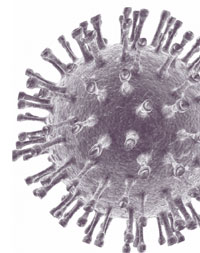HIV-1 Qualitative Assay vs. HIV Proviral DNA Assay
 On May 18, 2009, Warde Medical Laboratory began offering an HIV-1 Qualitative assay and this has caused some confusion about when it should be used. The HIV-1 Proviral DNA assay and the HIV-1 Qualitative assay are both available from Warde Medical Laboratory and the differences are shown in Table 1.
On May 18, 2009, Warde Medical Laboratory began offering an HIV-1 Qualitative assay and this has caused some confusion about when it should be used. The HIV-1 Proviral DNA assay and the HIV-1 Qualitative assay are both available from Warde Medical Laboratory and the differences are shown in Table 1.
HIV-1 Proviral DNA Tests.
HIV-1 Proviral DNA tests detect HIV-infected lymphocytes. During HIV replication, the virus creates a double-stranded DNA copy of its genome and this provirus is integrated into the DNA of the host cell. When the host cell replicates, the daughter cell also contains a copy of the proviral DNA.
A positive HIV-1 Proviral DNA result indicates HIV-1 infection but it does not provide information about virus replication. HIV-1 Proviral DNA testing is indicated for testing infants born to HIV-positive mothers, resolving indeterminate western blot results, and for detecting early HIV infections.
HIV-1 Proviral DNA testing was originally used to resolve indeterminate western blots because this test was significantly more sensitive than the RNA viral load assays available at the time. In 2006, the FDA approved an HIV-1 RNA test (Gen-Probe, Inc.) that had approved claims for detecting acute or primary infection and for confirming HIV-1 infection in individuals who are repeatedly reactive for HIV-1 antibodies (1). The Limit of Detection (95% confidence limit) for the Gen-Probe assay is 30 copies/mL (1). The Abbott HIV-1 Qualitative assay has a Limit of Detection (95% confidence limit) of 20 copies/mL.
HIV-1 Qualitative Assay.
The HIV-1 Qualitative Assay detects the HIV-1 RNA genome in virus particles in plasma. A positive result indicates that viral replication is occurring. This procedure utilizes a real-time reverse-transcriptase PCR procedure from Abbott Molecular Systems to amplify a portion of the pol/integrase region of the HIV-1 genome. This region is highly conserved. This procedure will accurately detect group M subtypes as well as group O and N isolates. This test may be used to resolve indeterminate HIV western blot results and to detect early HIV infection especially in patients who may have non-B subtype HIV infections (2, 3). The Centers for Disease Control and Prevention recommends the use of plasma RNA testing in conjunction with an HIV antibody test in cases where acute retroviral syndrome is suspected (4, 5). The HIV-1 Qualitative Assay can be used for this purpose.
In a recent paper from UCSF, Hatano and colleagues used the Aptima HIV assay to evaluate low-level viremia in patients who control HIV in the absence of antiretroviral therapy (6). The Abbott HIV-1 Qualitative assay has at least as good, if not better sensitivity than the Gen-Probe assay.
The HIV-1 Qualitative assay is not a replacement for the HIV-1 Proviral DNA test and both tests are available from Warde Medical Laboratory. In Summary, the HIV-1 Qualitative testing may be advantageous in the following circumstances:
- Detection of acute retroviral syndrome
- Detection of early HIV-1 infection, especially when non-B subtype HIV strains are a possibility
- Resolving indeterminate western blot results
- To evaluate low-level viremia in patients who are HIV-1 antibody positive.
Please contact Dr. Wiedbrauk (800-876-6522) if you have any questions.
Literature Cited
- Gen-Probe, Inc. Aptma HIV-1 Qualitative Assay Package Insert. 501623-ART Rev. A.
- Cunningham P, Marriott D, Harris C, Hancock S, Carr A, Cooper D. False negative HIV-1 proviral DNA polymerase chain reaction in a patient with primary infection acquired in Thailand. J Clin Virol. 2003 Feb;26(2):163-9.
- Bøgh M, Machuca R, Gerstoft J, Pedersen C, Obel N, Kvinesdal B, Nielsen H, Nielsen C. Subtype-specific problems with qualitative Amplicor HIV-1 DNA PCR test. J Clin Virol. 2001 Feb;20(3):149-53.
- Centers for Disease Control and Prevention. Revised Recommendations for HIV Testing of Adults, Adolescents, and Pregnant Women in Health-Care Settings. MMWR 2006;55(No. RR-14):1-17.
- US Department of Health and Human Services, Panel on Clinical Practices for Treatment of HIV Infection. Guidelines for the use of antiretroviral agents in HIV-1–infected adults and adolescents. Washington,DC: US Department of Health and Human Services; 2006. Available at http://www.aidsinfo.nih.gov/ContentFiles/AdultandAdolescentGL.pdf
- Hatano H, Delwart EL, Norris PJ, Lee TH, Dunn-Williams J, Hunt PW, Hoh R, Stramer SL, Linnen JM, McCune JM, Martin JN, Busch MP, Deeks SG. Evidence for persistent low-level viremia in individuals who control human immunodeficiency virus in the absence of antiretroviral therapy. J Virol. 2009 Jan;83(1):329-35.
Table 1. Comparison of the HIV-1 Proviral DNA test and the HIV-1 Qualitative Assay.
| HIV-1 RNA Qualitative | HIV-1 Proviral DNA | |
| Specimen (minimum) | 7 mL blood (3 mL EDTA or ACD plasma) | Whole blood 10 (3) mL |
| Limit of Detection | 20 copies/mL | 35 copies/million cells |
| Test Performed | M, W, F | T, Th |
| Assay Target | pol/integrase region of} the HIV-1 RNA genome | Integrated HIV-1 proviral DNA |
| Positive Result Indicates | HIV-1 Replication | HIV-1 Infection |
| Evaluation of infants born to HIV-infected women | No | Yes |
| Resolving Indeterminate Western Blots | Yes | Yes |
| Detecting Early Infections | Yes | Yes |
| Detecting Early Infections with non-B clades | Yes | No |
| Evaluating Low Level Viremia | Yes | No |
| Evaluating Acute Retroviral Syndrome | Yes | No |

